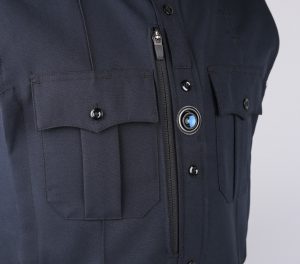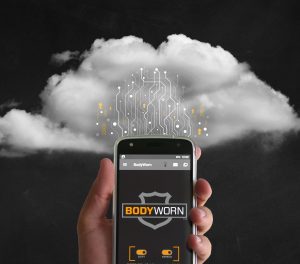Police body-worn camera technology has come a long way over the past decade in helping officers protect their communities. As more law enforcement agencies implement body-worn camera programs, police chiefs and administrators continue to wrestle with many of the logistical challenges and limitations that plague first-generation body-worn cameras. These issues still prevail in most body-worn cameras available for purchase today.
One of the real-world complaints most often heard from uniformed officers who use first-generation bodycams is they fall off their uniform regularly when they are needed most—during an altercation with a suspect. Every patrol officer knows ANY item hanging off the uniform is likely to fall off when the officer is in a tussle with a suspect or involved in a foot pursuit. It could be a corded radio mic, the officer’s name tag, or most importantly, a sizable body-worn camera held on to the uniform with a magnet or a clip.
Another problem and limitation with first-generation body-worn cameras is the requirement to “dock” the camera at the end of the patrol shift and wait for the video evidence to offload from the device. Officers wanting to review their body-worn camera video for documentation and accuracy of an arrest or interaction before they complete their detailed report usually have to wait hours for the video to become available to review.
The common denominator of these first-generation body camera challenges for police administrators is security—the video evidence is most vulnerable when it resides on the body-worn camera alone. The body-worn camera is at risk of falling off in the field along with the video evidence it contains. This video evidence is also lost forever if the body-worn camera doesn’t get “manually docked” at a police station for the video to be offloaded and secured.
Second-Generation Tech Solves Video Security Issues in the Field
The West Lafayette, Indiana, Police Department (WLPD) started deploying body-worn cameras in the field nearly a decade ago. Since WLPD was one of the early adopters of body-worn cameras, the department represents a good case study in the evolution of the technology and some hard lessons learned along the way. In early 2015, the agency was sued for excessive force by a Purdue University graduate student who had been arrested while interfering with the arrest of two other suspects on drug possession charges. During the arrests and subsequent physical altercation with the interfering student, the arresting officer’s first-generation clip-on body camera came off of his uniform and fell to the pavement. For the next several minutes, the clip-on body-worn camera recorded the sidewalk instead of the arrest of the resisting suspect. After the student discovered there was no body-worn camera video of his arrest, he filed a federal lawsuit against the police department for excessive use of force. Subsequently, the city’s insurance company made a business decision to settle the case out of court in 2016 for a payment of $42,500 to the graduate student. The bottom line is the first-generation clip-on body-worn camera fell off and forced the agency’s insurance company to settle.

Fast forward to 2017, when the WLPD looked to the evolving body-worn camera market for a solution to address the insecurity of clip-on body-worn cameras and the vulnerability of the video evidence on the cameras before they are docked for secure video offload. By this time the WLPD had lost two body-worn cameras in the field, along with the video evidence they contained, simply because the cameras fell off of officers’ uniforms. A comprehensive review of latest body-worn camera technology confirmed there was a much better option for securing body-worn cameras and the valuable videos they capture of officers interacting with the public they serve.

Integration of the body-worn camera into the officer’s uniform is now a reality. Integrating the body-worn camera into the uniform completely eliminates the problem of cameras falling off. Thin state-of-art smart cameras allow for secure body-worn camera placement between officers’ uniform garments and their protective body armor. With this placement, the body-worn camera can no longer be ripped off or fall off of the officer’s uniform.

Additionally, and maybe most importantly, smart body-worn camera advancement now equates docking stations to buggy whips! Connected body-worn cameras allow for secure video offload from the camera to the cloud in real-time via the cellular network. The moment an officer captures video in the field on a smart body-worn camera, the video file instantly and securely offloads from the device. This connectivity also means that live-streaming body-worn camera video to a command post, desktop, or MDT is now possible.
Due to the significant advancements in body-worn camera technology today, any police chief considering a body-worn camera solution or updating an existing first-generation bodycam program should focus on both physical and virtual security of body-worn cameras and video evidence.
Just like police departments have moved on from Blackberries and revolvers to smartphones and semi-automatic sidearms, they should take advantage of the benefits of second-generation body-worn cameras.
 |
Chief Jason Dombkowski retired in January 2019 after 25 years of service with the West Lafayette, Indiana, Police Department (WLPD), where he served as the city’s chief of police from 2008 to 2019. Currently, he is the director of law enforcement relations for BodyWorn by Utility, Inc. Under Chief Dombkowski’s leadership, the WLPD was the first law enforcement agency to deploy police body-worn cameras in Indiana, beginning in 2012. He is a U.S. Department of Justice body-worn camera subject matter expert, as well as a past president of the Indiana Association of Chiefs of Police. |
BodyWorn by Utility, Inc. provides an integrated body camera, in-car video, and digital evidence management solution to law enforcement agencies across the United States. BodyWorn is the industry leader in Policy-Based Recording, incorporating real-time communications and multiple exclusive automatic video and audio recording triggers based on policies, such as
bodyworn.com | 1-800-597-4707 |



